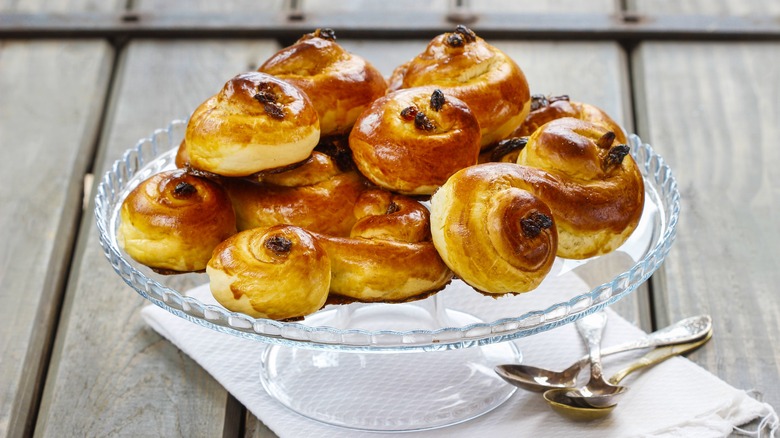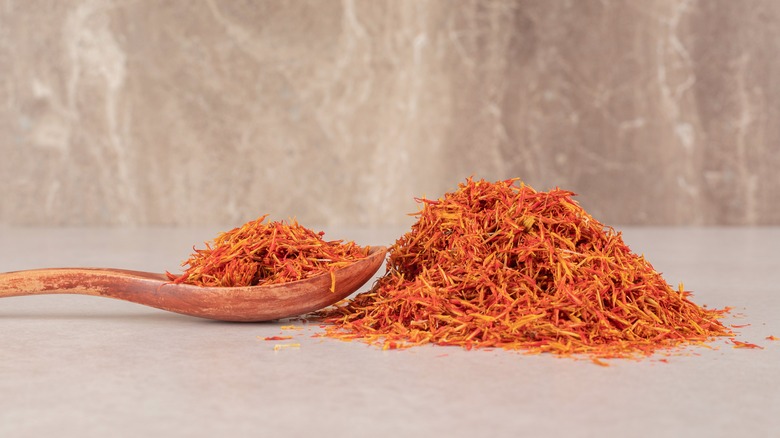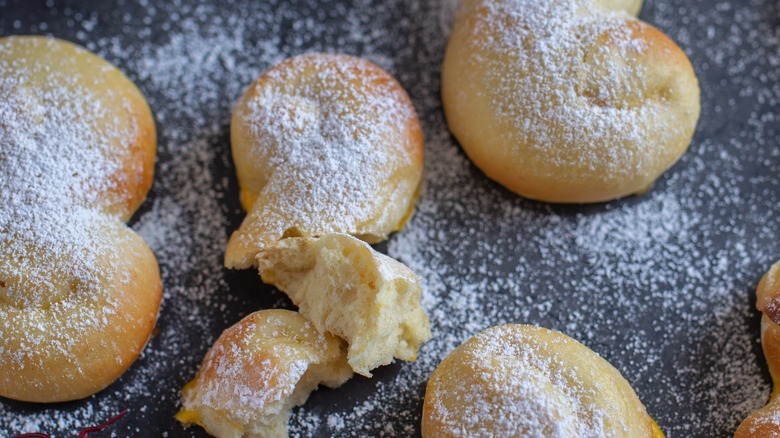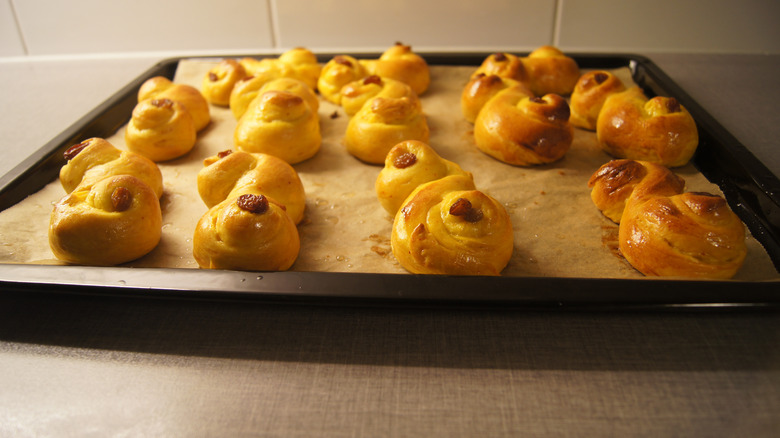Scandanavia's Iconic St. Lucia Buns Are A Saffron-Hued Delight
The end of the calendar year always seems to spark the most festive feelings and stir up the deepest hungers. There's lots of recipes for warm, hearty foods that are enjoyed by those graced with colder winters in the northern hemisphere. And, even saffron has made long journeys away from its equatorial home to find a place amongst winter traditions.
In the far northern regions of Scandinavia, St. Lucia buns or Lucia saffron buns (also lussekatter in Swedish, luciaboller in Danish, and lucia-pullat in Finnish) is the name of a popular sweet bread dish that is widely prepared and consumed around the end of the year, per Swedish Food. These light, bun-shaped breads are usually curled up into tightly wound shapes that resembles and curled up cat and feature two raisins that are meant to be eyes.
Flavored and scented with fragrant saffron and served as fresh as possible, these lussekatter are so good you could almost miss their coiling history or odd namesake. Almost.
The origins and history of St. Lucia Buns
According to Saveur, saffron made its way to Scandinavia from where it is grown and farmed in Northern Africa (Morocco), Southern Europe (Greece, Spain, Italy), and Western Asia (Iran, Afghanistan, India) around the 1300's, per Frontiers in Plant Science, via trade routes between Asia and Europe. This tasty and familiar spice was no doubt in the minds of bakers across the region as the buns became associated with both Christian and more ancient pagan traditions, per Atlas Obscura.
According to Atlas Obscura, lussekatter are usually eaten specifically on St. Lucia's day, which falls on December 13, honoring a Christian martyr that had died in the 4th century. Older traditions note that the date December 13 happens to fall on the winter solstice and the name Lucia is Latin for "light." Lucia (and the saffron bread that is served on the day) came to become a symbol of warmth and light on this darkest, coldest, and longest night of the year– and so did her cats.
What's in a name (and shape)
Lussekatter are formed into curly "S" shapes and added with raisins for eyes to represent curled up cats, per Swedish Food. As apt a comparison of a warmed curled up cat is to these similarly warmed curled up saffron scented breads, older documentation seems to indicate that there are also other animal shapes that were popular (notably the lussegalt or Lucia's pig), per Swedish Spoon.
Lussekatter, according to Spatula Desserts, is named for Lucia's cats. And while the exact link between St. Lucia and cats has been lost to time, the good holiday money is on the dövelskatter. According to Atlas Obscura, dövelskatter or "devil's cat" was the original name for these saffron buns, but this too seems to be a confusing misnomer as the word actually has very little to do with cats. Historians have found evidence that dövelskatter actually originates from a Dutch winter festival called duivekater, which itself translates to "devil's tomcat" or "devil's cake," which accounts for both the name and the shape of the modern lussekatter.
Grab the saffron and get to baking
It's time to make one of these cats (or pigs or whatever other shape you'd like). Making lussekatter is actually quite simple and only takes a few ingredients: milk, butter, flour, eggs, salt sugar, raisins, and saffron, per The Spruce Eats.
The real interesting part is infusing the saffron into the butter, milk, or some kind of liquor to set this lussekatter apart from just any old bun in the kitchen. According to Spatula Desserts, you want to grind it up very fine, mix it into your melted butter or other liquid, and let it sit for at least 15 minutes so it has time to infuse. Once you've finished making the dough, tear off pieces and roll them into snakes. Curl the snakes on either end so you get a curly-looking, deliciously-tasting dough bowtie (dough-tie) and remember to stick those raisins on just the right spots. After all, you don't want your cats to be cross eyed.



